Khenpo Karthar Rinpoche to teach on the lives of the Traleg Rinpoches
Khenpo Karthar Rinpoche to teach on the lives of the Traleg Rinpoches |
- Khenpo Karthar Rinpoche to teach on the lives of the Traleg Rinpoches
- Robyn Brentano named Executive Director of Garrison Institute
- Buddhism in China: An Enduring Legacy on View at the Freer
- Ladakh Festival to include Dhamma and meditation teachings
- Voyage hallyu: K-Pop meets Temple Stay
- Collected Works of Korean Buddhism
- Clear Seeing Eyes
- Acts of compassion
- Seven Korean monasteries seek UNESCO World Heritage
- Ashin Gambhira: “Why encourage racism, why create a crisis?”
- Video: Talking “Samsara”
| Khenpo Karthar Rinpoche to teach on the lives of the Traleg Rinpoches Posted: 31 Aug 2012 07:00 AM PDT  Khenpo Karthar Rinpoche Khenpo Karthar Rinpoche will be giving a special teaching on the lives of the Traleg Rinpoches at the E-Vam Institute in Chatham, New York, from September 28 to 30. Khenpo Karthar Rinpoche had a long connection with Traleg Kyabgon Rinpoche, the ninth Traleg Rinpoche, who died in July. When Khenpo Karthar was training at Thrangu Monastery in Eastern Tibet, he was a student of the eighth Traleg Rinpoche, and after the Chinese invasion of Tibet in the 1950s, that connection was preserved for decades with the ninth Traleg Rinpoche. Born in Eastern Tibet in 1924, Khenpo Karthar Rinpoche is widely recognized as one of the great masters of the Karma Kagyu school of Tibetan Buddhism. He is the founder of Karma Triyana Dharmachakra and over 30 other affiliated centers throughout the Americas. The lectures are scheduled for Friday, September 28 at 7 p.m., and Saturday and Sunday from 10:30 a.m. to noon and from 3:30 to 5 p.m., at the E-Vam Institute, 171 Water Street in Chatham, New York. The course costs $ 140 for sustaining members, $ 157.50 for full or family members, and $ 175 for others. Costs per session are $ 28, $ 31.50, and $ 35. Accommodations are available for $ 30 a night in a private shared room or $ 25 a night in a dormitory. To register, or for more information, please email office@evam.org or call 518 392 6900. Read More @ Source |
| Robyn Brentano named Executive Director of Garrison Institute Posted: 31 Aug 2012 06:00 AM PDT
"We're very lucky to have Robyn leading the Institute," says Board Chair and founding President Emerita Diana Calthorpe Rose, in Garrison's formal announcement. "She is exactly the right person to guide the Institute through the next phase of growth and raise the impact of its work to the next level." "I am honored to be stepping into this position at this point in The Garrison Institute's development," Brentano says. "By pioneering effective approaches to social and environmental change rooted in contemplative insight and practice, the Institute is having a powerful impact on fields of vital importance to our future. The Institute's initiatives tie together many threads of my own career and present an ideal opportunity to work with a highly creative board, staff and partners to advance knowledge and build transformational leadership." Click here for more from the Garrison Institute's announcement and to read more about Brentano's multifaceted career. Read More @ Source |
| Buddhism in China: An Enduring Legacy on View at the Freer Posted: 30 Aug 2012 07:00 PM PDT The Smithsonian, August 29, 2012Washington, DC, USA -- Though Buddhist was not native to China, curator Stephen Allee says it wasn't a hard sell. "It's a religion of salvation, and so it had great popularity and appeal," he says.
As curator of the Freer Gallery's new exhibit, "Enlightened Beings: Buddhist in Chinese Painting," Allee points out that missionaries and traders traveled across the Silk Road in the first century BCE, and over the centuries, they gained a court audience, making Buddhist an integral part of Chinese culture. The exhibit's 27 works, ranging from the 11th century to the 19th century, tell the story of both Buddhist thought and its adoption in a new land. The lens may seem wide-angle but historical memory holds an important place in a religion that records the transmission of its dogma from person to person. Within a single painting in the exhibit, for example, are representations of 53 generations beginning with Buddha and continuing all the way into the 16th century. The work is meant to record the unbroken transmission of Buddha's teachings across time.
Allee explains that though China had many native philosophies and religions at the time, few of them dealt with the idea of the afterlife satisfactorily. Thus, the promise of reincarnation, salvation and nirvana appealed to many when Buddhist reached them from northern India. Though salvation was the name of the game, there were other paths practitioners could take. One group, the Bodhisattvas, for example, achieve enlightenment but stay on Earth to aid in the salvation of others. Another, the Luohan, meanwhile, also choose to remain on Earth to protect the teachings of Buddhist. The exhibit also features depictions of lineage masters and Zen monks. Describing Zen, or Chan, monks as eccentric, Allee explains that Zen Buddhist relied on a wordless transmission rather than strict understanding of dogma. "Buddha gave a sermon and one of his followers asked a question," says Allee. "Instead of answering, he simply held up a flower and the follower instantly achieved enlightenment." A native product of China in the fifth century, Zen Buddhist became associated with its own style of expressive brushwork. While monks sometimes produced the artworks, patrons could also commission works for temples or for their own homes. Common in both were representations of the four directional gods. Vaisravana, guardian king of the North, served to protect temples and practitioners. He also became associated with wealth, making him all the more popular, says Allee. In one 14th-century ink and color silk painting from China, the artist has included Central Asian dancers and Chinese scholars, thus depicting the religion's broad geographic and historical reach. "Enlightened Beings: Buddhist in Chinese Painting" opens September 1 and runs through February 24, 2013. Read More @ Source |
| Ladakh Festival to include Dhamma and meditation teachings Posted: 30 Aug 2012 06:00 PM PDT by Lee Yu Ban, The Buddhist Channel, Aug 31, 2012Leh, Ladakh (India) -- The region of Ladakh lies tucked away in north India amidst the remote valleys of the western Himalayas.
Every year the Ladakh festival takes place from September 1st to the 15th in Leh and nearby villages and stretches till late September, ending just before the winter cold begins again. The Festival highlights the sports and culture of the region, starting off with a long and colourful procession through Leh. What follows is a week of cultural performances,craft stalls, local food and sports such as archery contests, polo matches, white-water rafting expeditions and treks.
It has since grown into a campus of several buildings including residential schools , homes for the aged and the blind and monasteries for monks and nuns. It also features a well equipped retreat centre set into a rock face and offering spectacular vistas of the Indus valley. The popular 3 day and 10 day retreats, held at this Centre has been an open secret among Buddhist pilgrims,trekkers, and other visitors for several years. It is expected that this program will be a popular feature of the Festival allowing visitors to drink deeply from the spiritual heritage of Ladakh. Read More @ Source |
| Voyage hallyu: K-Pop meets Temple Stay Posted: 30 Aug 2012 05:00 PM PDT by Emi Hailey Hayakawa, BTN, Aug 30, 2012Seoul, South Korea -- Korean Pop music, otherwise known as K-POP, has allured many French people into Korean pop culture, and now these people have become enchanted by the Korean Temple Stay program.
VOYAGE HALLYU was a special package created by the Korean Ministry of Tourism and with various travel agencies for foreigners in response to the popularity of K-POP and Korean culture. During their stay in Jeondungsa Temple, the 40 participants were taught the basic customs of the Korean traditional monastic life by Ven. Haein, and experienced the monastic way of eating through balwoo gongyang (bowl offerings). On the second day, their schedule included early morning Buddhist chantings, meditation, 108 prostrations, Morning bowl offerings, and walking meditation at the mountain adjacent to the temple. The participants was delighted to be immersed in nature, and away from the everyday bustle and hustle of modern life.
The creator of VOYAGE HALLYU, CEO of CapCoree, Fredrick states that "In France K-POP is quite popular and represents the modern Korean Culture. The Temple stay program represents the traditional Korean Culture and VOYAGE HALLYU lets participants experience both the modern and traditional Korean Culture." He carries on to say that "..the Temple stay program is a completely new experience for French people as most of them are Catholic. Thus, I am happy that we are able to offer an opportunity for many people to experience the traditional culture and to promote a better understanding of Asia." Read More @ Source |
| Collected Works of Korean Buddhism Posted: 30 Aug 2012 04:00 PM PDT by Emi Hailey Hayakawa, BTN, Aug 29, 2012Seoul, South Korea -- The "Collected Works of Korean Buddhism," a 13 volume series of teachings by the three great Buddhist masters of Korean Buddhism; Wonhyo (617-686), Jinul (1158-1210) and Hyujeong (1520-1604) was published in English on August 23rd 2012.
In the Press Release released by the Jogye Order on August 21st, it stated "...Beginning from 2006, we began this project to further propogate Korean Buddhism across the globe, and selected over 90 teachings from the great masters of Korean Buddhism for the 'Collected Works of Korean Buddhism'.." And it continued to state that "This series is mainly for scholars for further research and propagation of Korean Buddhism.." Various local and foreign scholars were involved in this project including Dr. Robert Buswell, the director of the Buddhist Center at UCLA, Dr. A Charles Muller, an Academic scholar and professor at Tokyo University specializing in Korean Buddhism and East Asian Yogacara, and Ven. Haeju of Dongguk University. Read More @ Source |
| Posted: 30 Aug 2012 03:00 PM PDT 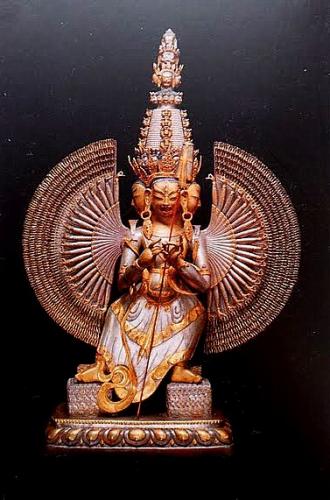 Ushnishasitatapatral Bodhisattva who represents the canopy of white light that emanates from the Buddha's head in the creation of the Surangama Mandala
The Surangama Sutra This is especially for those who care for their eyes and who aspire to the clear seeing eyes pointed to in this extract from the Surangama Sutra. As we know there is more to seeing than meets the physical eye! And for those of you who find this kind of devotional thing a bit of a challenge. Don't worry yourself. Open your heart and the light will come in. You might try adding that valuable little word intend to that last sentence. Intend to open your heart and the light will come in. Read More @ Source |
| Posted: 30 Aug 2012 02:00 PM PDT by Stanley Koh, FMT, August 30, 2012
The Hungry Ghost Festival is an occasion to harmonise separate dimensions of existence. Kuala Lumpur, Malaysia -- Chinese rituals to appease hungry ghosts, regardless of whether they are enacted within the Taoist or Buddhist tradition, express the desire of believers to live in harmony with aggrieved and neglected "wandering spirits".
Zhong Yuan Jie, known in English as the Hungry Ghost Festival, begins on the first day of the seventh Chinese lunar month, which coincides this year with Aug 30, today. For one month, families pray on roadsides or at crossroads in a simple late evening ritual that feature the burning of joss sticks and offerings of food and paper money. Similar rituals conducted by business communities are often more elaborate. For example, the array of foodstuffs may be wider and richer and the programme could include an opera show or even modern dance and pop music.
The festival, to both Taoists and Buddhists, also has the function of teaching filial piety to the young. Furthermore, the rituals are supposed to ensure that the restless spirits do not intrude into the lives of the living or bring them physical harm or some other form of misfortune. Who or what are these wandering, homeless spirits? They are believed to be the ghosts of those who died violent deaths or died before fulfilling strong desires. Sometimes, though, they could simply be spirits whose living relatives have long neglected them. Chinese folklore and some claimed Buddhist texts mention various types of wandering ghosts dwelling in hell, which is said to be a dimension close to that of the physical universe. They are invisible in the daylight hours but become visible to some people after dark . The origins As to the origins of the Hungry Ghost Festival, there are several traditional versions, but we will deal here with the Buddhist version, which is interesting because it is traced back to one of the chief disciples of the historical Gautama Buddha himself. This disciple's name was Muadglayana. In Chinese, he is called Mu Lian. Mu Lian, having learned from his deceased father that his mother was suffering in hell, sought advice from Gautama on how to deal with the situation. The Great Master told him that he could alleviate her torment by conducting, in the seventh lunar month, an elaborate ritual that would include the chanting of sutras, sacrificial offerings and the transferring of merits. Mu Lian did all these and saved his mother from further suffering. As intimated earlier in this article, one of the key beliefs associated with the festival is that spirits can and do take revenge for injustices that caused the death of their earthly bodies. And neither is this belief confined strictly to Chinese tradition. It exists, with modifications, in the belief systems of various other cultures, both east and west. Connoisseurs of English literature, for example, are familiar with the story of Hamlet as told by Shakespeare. Hamlet is asked by the ghost of his father to avenge his murder. What, then, is a sensible approach to take in considering this issue of spirits and ghosts? To sceptics, perhaps no explanation is sensible if it does not include material evidence. Perhaps, in matters such as these, only personal experience can convince the cynic. To me, ghosts are as real as anything that can be perceived with the physical senses. And that is because I have had a ghostly encounter. I was neither hallucinated nor drunk at the time. I was a Buddhist monk and alcohol was forbidden at the monastery. I also had an out-of-body experience, during which time my physical self was as good as dead. However, my spirit soon re-entered my body – unfortunately, perhaps. If we were to ponder upon the issue with an open mind, we will find that it is neither absurd nor illogical to accept the idea that there is a spirit world. A human being is made up of three components – the physical body, the mental-cum-emotional body and the spiritual body – all with different levels of human consciousness. (According to many documented cases, this is true even with the lower animals.) The "astral body", as it is known to students of occultism and metaphysics, is the vehicle of emotion, passion and sensation. Is an astral body equivalent to a "spirit" reborn after physical death? Other dimensions of existence In his book "The Astral Body", A.E. Powell writes: "In the case of a man who has led such an evil life that his astral and mental bodies are torn away from the ego after death, the ego, having no bodies in which to live in the astral and mental worlds, must quickly form new ones. "When the new astral and mental bodies are formed, the affinity between them and the old ones, not yet distinguished, asserts itself, and the old mental and astral bodies become the most terrible form of what is known as the 'dweller on the threshold'. "Thus chained, [the dweller] cannot go onward to rebirth. He is conscious in the astral world, has his human faculties, but cannot control the brute body with which he is connected, nor express himself through the body on the physical plane. "Such an imprisonment is not reincarnation, though it is easy to see that cases of this nature at least partially explain the belief often found in Oriental countries that man may under certain circumstances reincarnate in an animal body." We have to acknowledge that we are in spirit form encased in a physical body. If that is the case, is it not logical to say that there are spirit worlds which we will eventually realise after our death? Psychiatrist Brian L Weiss, who wrote the bestseller "Messages from Masters", speaks of different dimensions of existence. "When I talk about other dimensions, I mean other energetic states or even different levels of consciousness, not necessarily other planetary systems or galaxies," he writes. "Heaven can be considered another dimension, since energy transformation beyond three-dimensional consciousness is undoubtedly involved." And Weiss is just one of an ever increasing number of scientifically minded professionals who believe in multi-dimensional worlds and their interpenetration. Read More @ Source |
| Seven Korean monasteries seek UNESCO World Heritage Posted: 30 Aug 2012 01:00 PM PDT by Emi Hailey Hayakawa, BTN, Aug 29, 2012Seoul, South Korea -- The Presidential Council on Nation Branding began its research and investigation for the application of the UNESCO World Heritage Site at 7 monasteries in Korea.
The seven monasteries includes Beopjusa Monastery, Tongdosa Monastery, Buseoksa Monastery, Bonjeongsa Monastery, Magoksa Monastery, Seonamsa Monastery, and Daehungsa Monastery. All of these monasteries boast a history of over 1000 years and various important historical and cultural assets within their domain. The Council met on August 10th at the Ministry of Cultural Assets for a meeting regarding the strategies for the application of the UNESCO World Heritage Site at the 7 monasteries in Korea. The Presidential Council on Nation Branding began its research and propulsion for the application of the UNESCO World Heritage Site after President Lee Myung Bak attended the council meeting in 2011 and emphasized the importance of traditional folk culture heritage. Thus, in April and May of 2012, the Council created the Specialist Council and began having meetings regarding the application of UNESCO World Heritage Site for various gardens and monasteries.
On July 26th 2012 the Council announced the open applications for various enterprises in the planning and operation and PR for the Academic Forum, and the closing date will be on October 15th 2012. During these dates, there will be major planning for the Academic Forum to further inform the public regarding the importance and historic assets of the 7 pre-elected monasteries. Beobjusa monastery stated that they have created and is currently propulsing an operations committee for the preparations of the application of the UNESCO World Heritage Site along with the Ministry of Cultural Assets and the Jogye Order of Korean Buddhist. Beopjusa temple currently holds the National treasure 55, the Palsangjeon Hall of Beopjusa temple, and 15 other National treasures and 300 Buddhist cultural assets. Adjacent to the temple, there is various hermitages, cliffs, etc which makes this temple both historically and naturally important. In Tongdosa monastery, otherwise known as the Buddhist jewel temple, lays National treasure 290, the Daeungjeon Hall and stairs of Tongdosa temple, and holds 19 other treasures. Seonamsa monastery holds National treasure 400, the beautiful Seungseon bridge and 15 other important treasures. BongJeongsa monastery has the oldest wooden buliding Geungnakjeon Hall of Bongjeongsa temple, otherwise known as National Treausure 15, and other important architectures that are national cultural assets. They also have an important rock carving of the Maitreya and is said to be the most important national rock carving. Buseoksa is said to have the most beautiful wooden structure, the Muryangsujeon Hall of Buseoksa Temple, otherwise known as National treasure 18, and Seated clay Buddha statue of Buseoksa temple (National treasure 45). Additionally Wall painting in Josadang Hall of Buseoksa temple (National treasure 46) and Josadang Hall of Buseoksa temple (National treasure 19) and boasts of other treasures and cultureal assets. Magoksa temple holds various Buddhist cultural assets such as the Daeungbo Hall (treasure 801) and Daeheungsa temple is mostly known for North rock-cut seated Maitreya buddha of Daeheungsa Temple designated National treasure 308. Thus, there will be an Academic Forum in further informing of the various national treasures, cultural assets, and Buddhist assests of the 7 monasteries, and its' historical, cultural, and Buddhist importance, and will lead to the UNESCO making its designation in December of 2012. Read More @ Source |
| Ashin Gambhira: “Why encourage racism, why create a crisis?” Posted: 30 Aug 2012 12:00 PM PDT Thebestfriend.org, Aug 29, 2012Yangon, Myanmar -- Saffron Revolution leader Ashin Gambhira (aka Ko Nyi Nyi Lwin) has been struggling with his health since his release from prison earlier this year. In a new letter, he speaks about the current conflict in Arakan State, and the fighting between Muslim Rohingyas and Buddhist Rakhines.
The Military relies on conflict to stay in power "The violence between Rakhines and Rohingyas in Arakan State is an example of how dictatorships all over the world use and rely on conflicts to stay in power. If all people were united, a military dictatorship could not survive. Division and enmity in the minds of the people only keep the military strong. Because of this, the military systematically uses division-and-rule policies on the grounds of nationality, religion, economic and education status, etc., to divide people, to keep the military 'necessary', relevant, and in power. So the Burmese people are kept separated in groups, each group for themselves, without unity or cooperation. Everybody lives in fear and distrust of the other. Everyone sees the other with a suspicious mind. With this pressure, the people are defeated. Nationalism is used to the keep the military system alive
The thirst for human rights "We haven't had human rights or true democracy in our country for over fifty years. For the last fifty years and five months, an old man couldn't get a taste of democracy, human rights, freedom, justice, or equality. Some people have not known any of these things their entire lives. This means we were so thirsty for human rights that we sometimes demanded them like fools. "We are living in the 21st century now, in a time of globalization, but in our country the principles of human rights and democracy are terribly broken. So our understandings of Dhamma, Metta, peace, and human rights are very rough, and we are beaten, arrested, killed, and destroyed. "Mr. Tomas Ojea Quintana, the UN Human Rights Commissioner, has said clearly that during the 2007 Saffron Revolution, crimes against humanity were committed. The illegal government acted against me with unjust laws and rules. I was sentenced by a judge to 68 years in prison. I lost my time, health, education, and freedom for the sake of my motherland. I spent nearly 4 years in prison. Everyone around the world knew that the people and monks were marching non-violently with love, Dhamma, and peace, and we didn't have as much as a nail with us. But we were broken down very violently, beaten, shot, and killed. "The same people who were ruling Burma then are now presenting themselves to the world as a legal government. They show themselves to be honest, polite, and clear. But nothing has changed in Myanmar, even in this changing period. The neo-military dictatorship has exploited and fostered a new national crisis, a religious conflict, the Rakhine-Rohingya conflict, for its own purposes. "This is a very simple and effective strategy. It has happened several times in the past. There have been conflicts between Buddhist monks and Muslims before. They have been fighting each other, and the military dictatorship benefited from it. These clashes were encouraged by the military to keep the people separated. "We had started a Metta campaign in our country with slogans for peace and democracy. The campaign includes members of all religions. But now, the Rakhine and Rohingya have turned against each other violently in front of the world. Even some members of the democracy movement have followed the threat of politics by the military regime and have changed sides. The rule of law "I want to say one additional thing. We need to count from the beginning. We only needed to judge with the rule of law those three Rohingyas who raped a girl. Rohingyas or Rakhines, Burmans or Shan, everybody must obey the rule of law. Why encourage racism, why create a crisis? Why blame only Rohingyas and put all of the purnishment on all of them? "In Bangladesh, in a minority village on the border with Myanmar, several people were robbed by Bengali groups. The Bangladeshi government took effective action against the robbers with the rule of law, and a crisis was averted. "I feel sad to know that some Buddhist monks have joined demonstrations and campaigns against Rohingyas. We already previously kindled a fire of Dhamma for everyone around the world to see in 2007. Do I need to explain in detail the meaning of the Buddha's words, of Metta, Dhamma, peace, ahitha, thitthar, ageha, for everyone? "As you know, my health is not so good, so I have been taking a rest lately. Actually, the past revolution experience was a very dark and hopeless situation inside the prison for me. I faced it, and survived this condition after I was released into the present political situation. I really want to write more about it. But I have to take care of my health first. In the future when I am better, I hope I can do it. Even writing this letter hurts my eyes and causes severe headaches. The deep pain inside my body is bad, but I needed to write and send this to you." ------------ |
| Posted: 30 Aug 2012 11:00 AM PDT For a while now we've been awaiting the arrival of Ron Fricke's new movie Samsara — a spiritual sequel, of sorts, to the masterful Baraka. Now, by way of The Telegraph, comes a new short interview with Fricke and producer Mark Magidson about Samsara, which they call a "guided meditation based on the themes of birth, death, and rebirth — with no words." Enjoy, and for more information about the film, click here. Read More @ Source |
| You are subscribed to email updates from BuddhaRocks ☸ Buddhist To stop receiving these emails, you may unsubscribe now. | Email delivery powered by Google |
| Google Inc., 20 West Kinzie, Chicago IL USA 60610 | |

 The Board of Trustees of the Garrison, New York's
The Board of Trustees of the Garrison, New York's  << Known as the transmitter of Chan, or Zen Buddhist, the Chinese monk, Bodhidharma, was said to have a volatile temperament. Portrait of Bodhidharma. Fourteenth century, ink on silk. Courtesy the Freer Gallery of Art.
<< Known as the transmitter of Chan, or Zen Buddhist, the Chinese monk, Bodhidharma, was said to have a volatile temperament. Portrait of Bodhidharma. Fourteenth century, ink on silk. Courtesy the Freer Gallery of Art.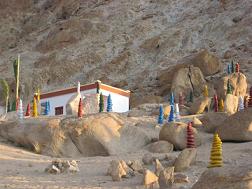 Cut off from the rest of the world for the better part of the year, it springs to life in a vibrant burst of colour through the summer when international tourists flock to this region 11,000 feet above sea level to take in its cultural delights, explore ancient monasteries,white-water rafting or trek into the green valleys hidden in the folds of the Karakoram range.
Cut off from the rest of the world for the better part of the year, it springs to life in a vibrant burst of colour through the summer when international tourists flock to this region 11,000 feet above sea level to take in its cultural delights, explore ancient monasteries,white-water rafting or trek into the green valleys hidden in the folds of the Karakoram range.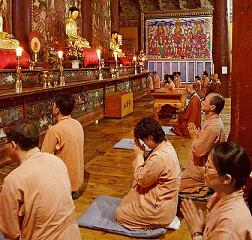 The Cultural Corps of Korean Meditation headed by Ven. Beop Jin, opened a 2 day Temple Stay program from August 16th to August 18th for the 40 French Tourists of the VOYAGE HALLYU group at Jeondungsa Temple in Incheon, Korea.
The Cultural Corps of Korean Meditation headed by Ven. Beop Jin, opened a 2 day Temple Stay program from August 16th to August 18th for the 40 French Tourists of the VOYAGE HALLYU group at Jeondungsa Temple in Incheon, Korea.  These rituals are regarded as acts of compassion from the living towards these unfortunate spirits because they enable them to "move forward" in their evolution.
These rituals are regarded as acts of compassion from the living towards these unfortunate spirits because they enable them to "move forward" in their evolution.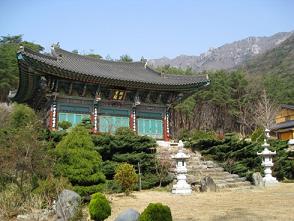 << Tongdosa Monastery, eyeing as UNESCO World Heritage site
<< Tongdosa Monastery, eyeing as UNESCO World Heritage site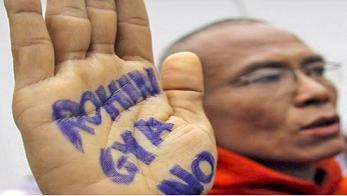 "I feel very sorry after reading the latest news. I don't feel so much surprised as angry because I knew something like this would happen soon. One step leads to another. It is actually not so surprising for our country Myanmar, because neither people nor politicians have good understanding."
"I feel very sorry after reading the latest news. I don't feel so much surprised as angry because I knew something like this would happen soon. One step leads to another. It is actually not so surprising for our country Myanmar, because neither people nor politicians have good understanding."